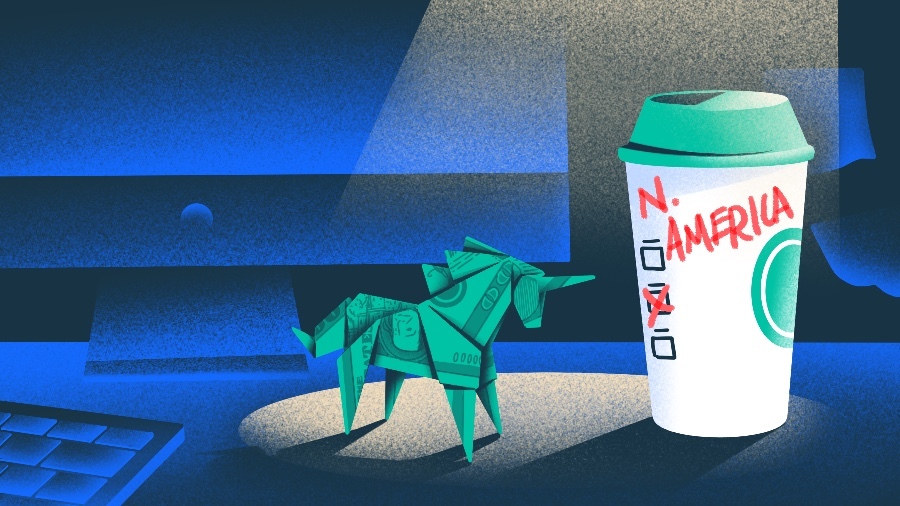The first quarter of 2021 was one of those rare periods in startup funding and exiting in which it seemed everyone was bullish about everything.
There were enormous late-stage funding rounds. Major public market debuts. Big M&A deals. Even early-stage was way up over the prior quarter and year-ago levels.
Subscribe to the Crunchbase Daily
Overall, investors put $72.7 billion into seed through technology growth-stage rounds for North American startups in the first quarter of this year, according to Crunchbase reported data. The total is the highest in the history of the dataset.
Funding in Q1 was roughly double year-ago totals. Investment also rose 57 percent from Q4, as detailed in the chart below:
Funding totals were juiced by massive individual rounds for hot unicorns. There were 194 rounds of $100 million or more in Q1, per Crunchbase data. While rounds of that size were once rare, it’s now routine to see several in a single day. Investors also scored some big exits, topped by public offerings for gaming platform Roblox and point-of-sale lender Affirm.
All told, it added up to quite an extraordinary quarter. We break down the major trends below, focusing on stages, big deals, M&A and public market debuts.
Late-stage funding
Late-stage funding was particularly strong in Q1, so we’ll start there.
For the just-ended quarter, investors put $51 billion to work in North American late-stage and technology growth deals. The Q1 totals were massively larger than any of the prior four quarters, as illustrated in the chart below. It was also the highest quarterly total in the history of the Crunchbase dataset.

Round counts also rose, with 432 reported deals, the highest total in five quarters. Average round size rose as well, totalling $122 million.
Of course, many of the deals were much bigger than that. The largest rounds include stock-trading app Robinhood ($2.4 billion pre-IPO round), cloud analytics platform Databricks ($1 billion Series G), Amazon retail aggregator Thrasio ($750 million Series C), process automation software provider UiPath ($750 million pre-IPO round), and payments tech provider Stripe ($600 million Series H).
Early stage
Early-stage dealmaking was also on fire. An estimated $19.7 billion went into Series A and B deals in Q1, per Crunchbase data, up 56 percent year over year and up 36 percent from the prior quarter. We lay out investment and round count totals for the past five quarters in the chart below:

Some of the largest funding rounds went to low-cost drug developer EQRx ($500 million Series B), scheduling app Calendly ($350 million Series B), and digital product design platform Quantum Metric ($200 million Series B).
The preponderance of supergiant early stage rounds ($100 million and up) also stood out. For Q1, Crunchbase tallied 38 supergiant Series A and B deals, up from 17 per quarter in both Q1 and Q4 of 2020.
Seed funding
Seed funding held up well in Q1, based on preliminary Crunchbase data, with roughly $1.9 billion invested. That’s essentially flat with the year-ago quarter and down about 10 percent from Q4 2020, as illustrated in the chart below:

Over time, we expect the seed-stage totals for Q1 to adjust higher. That’s because deals at the earliest stages often get added to the Crunchbase dataset a few weeks or months after they close.
While the typical seed deal is under $1 million, it’s common to see some bigger rounds as well. For Q1, larger seed investments for newer companies included $40 million for drug developer Bicara Therapeutics, $40 million for security provider ActZero.ai, and $30 million for vehicle subscription startup NXCR.
Exits
While venture investors were busy putting money into startups, they posted a strong quarter from the returns side as well. Both large IPOs and M&A deals were prevalent in Q1. In addition, a proliferation of SPACs provided an increasingly popular path to public markets for startups in hot sectors.
Public offerings
In terms of huge public-market offerings, Q1 of 2021 took a back seat to Q4 of 2020, which saw the massive debuts of Airbnb and DoorDash. However, Q1 was still by normal standards a very robust quarter for new offerings.
The two largest Q1 offerings, Roblox and Affirm, were recently valued at $39 billion and $18 billion, respectively. Several more are valued in the multiple billions. We lay out the biggest debuts in the chart below (Note: The chart shows valuation at IPO, and many company stocks have risen since then, while a few have fallen.):

Beyond companies actually going public, Q1 stood out for the high volume of companies that disclosed plans to do so. Heavily anticipated debuts on tap for the current quarter include crypto platform Coinbase, process automation software giant UiPath, and a long list of venture-backed companies that have announced plans to merge with a SPAC.
M&A
It was a productive quarter for M&A as well. There were 397 disclosed acquisitions of seed- or venture-backed companies in Q1, per Crunchbase data, the highest quarterly total of the past two years.
Altogether, venture-backed M&A deals with disclosed prices totaled $39.2 billion in Q1 (including some potential milestone-based payments). The sum total of M&A deals was higher, as a large portion of acquirers do not disclose purchase prices, particularly for deals under $100 million.
It was a strong quarter for large M&A deals involving venture-backed companies. Crunchbase counted at least eight such acquisitions in Q1, listed below:

Is this the peak?
With every record-breaking quarter, the question arises: Is this the top? Will valuations head down as VCs and public investors grow cautious? Will the party keep going?
One can think of plenty of reasons why this does not look like the peak. Venture firms are still flush with cash. Public markets, and tech in particular, are holding up at historically high valuations. And as America emerges from the pandemic, spending is likely to surge in many of the sectors hit hard in 2020.
That said, one can’t really see a peak from atop it. Like mountaintops, market peaks are only visible from below.
Methodology
The data contained in this report comes directly from Crunchbase, and is based on reported data for North America namely Canada and the United States. Data reported is as of April 6, 2021.
Note that data lags are most pronounced at the earliest stages of venture activity, with seed funding amounts increasing significantly after the end of a quarter/year.
The most recent quarter/year will increase over time relative to previous quarters. For funding counts, we notice a strong data lag, especially at the seed and early stages, by as much as 30 percent to 40 percent a year out.
Please note that all funding values are given in U.S. dollars unless otherwise noted. Crunchbase converts foreign currencies to U.S. dollars at the prevailing spot rate from the date funding rounds, acquisitions, IPOs and other financial events are reported. Even if those events were added to Crunchbase long after the event was announced, foreign currency transactions are converted at the historic spot price.
For M&A transaction analysis, we include venture-backed companies and exclude companies that previously went public.
Glossary of funding terms
Seed and angel consists of seed, pre-seed and angel rounds. Crunchbase also includes venture rounds of unknown series, equity crowdfunding and convertible notes at $3 million (USD or as-converted USD equivalent) or less.
Early-stage consists of Series A and Series B rounds, as well as other round types. Crunchbase includes venture rounds of unknown series, corporate venture and other rounds above $3 million, and those less than or equal to $15 million.
Late-stage consists of Series C, Series D, Series E and later-lettered venture rounds following the “Series [Letter]” naming convention. Also included are venture rounds of unknown series, corporate venture and other rounds above $15 million.
Technology growth is a private-equity round raised by a company that has previously raised a “venture” round. (So basically, any round from the previously defined stages.)
Illustration: Dom Guzman

Stay up to date with recent funding rounds, acquisitions, and more with the Crunchbase Daily.





![Illustration of agentive AI brain - Latin America - Quarterly. [Dom Guzman]](https://news.crunchbase.com/wp-content/uploads/Agentive_AI_lat-america-470x352.jpg)
![Illustration of agentive AI brain - Asia - Quarterly. [Dom Guzman]](https://news.crunchbase.com/wp-content/uploads/Agentive_AI_asia-470x352.jpg)
![Illustration of a guy watering plants with a blocked hose - Global [Dom Guzman]](https://news.crunchbase.com/wp-content/uploads/quarterly-global-3-300x168.jpg)
67.1K Followers